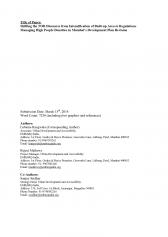
Lubaina Rangwala, Rejeet Mathews, Sanjay Sridhar
The 2011 Census report indicates a population of over 12 million people living in Mumbai city over an area of 427sq km. The Comprehensive Transportation Study of 2008 for the city and its region revealed that 51% of all trips (vehicular and non-motorised) are made by walk and 78.2% of purely vehicular trips are made by public transportation. This high usage of public transportation and walking modes are a result of dense, mixed use neighbourhoods that traditionally agglomerated around suburban railway stations.
High transit dependency and ridership has prompted city stakeholders to presume that Mumbai has naturally, over the years, adapted to transit stations; while this is probably true; current realities indicate a worrying trend. Regulations set in the existing development plan greatly incentivise ownership of private vehicles with excessive sops available to build parking structures, even close to railway stations. Suburbs are incentivised to proliferate in a bid to decongest the old city areas. Metro and mono rail alignments are under construction without considerations to integrate land use.
This paper argues that current regulations incentivize vehicles and built densities around transit nodes. There is a direct need to rethink these regulations and develop a comprehensive ‘transit oriented development’ approach towards managing high people densities around transit nodes.
If you have any questions or comments, or would like to know more about this research, contact Lubaina Rangwala at lubaina.rangwala@wri.org.
